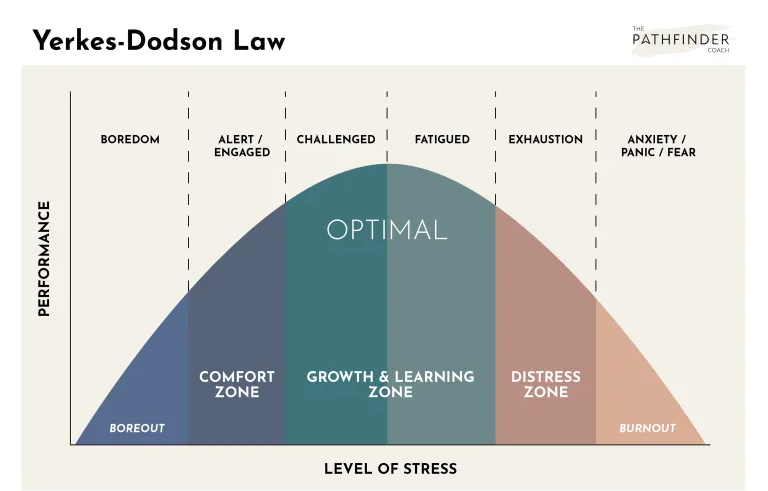In today’s world, the demands on our time, attention, and energy are relentless. Change is constant, uncertainty is high, and complexity is the norm. For anyone pursuing peak performance — whether you’re an entrepreneur, athlete, executive, or creative — understanding how your stress levels affect your performance can be the difference between sustained success and burnout.
That’s where the Yerkes–Dodson Law comes in — a century-old principle that’s more relevant than ever in our fast-moving, VUCA-driven world.
The Yerkes–Dodson Law in Simple Terms
Over 100 years ago, psychologists Robert Yerkes and John Dodson discovered something fascinating:
Your performance doesn’t improve endlessly with more stress or stimulation.
Instead, it follows an inverted U-curve:
- Too little arousal: You’re bored, distracted, or disengaged → performance suffers.
- Moderate arousal: You’re focused, energized, and in flow → performance peaks.
- Too much arousal: You’re anxious, overloaded, or burned out → performance drops sharply.
The sweet spot? A balanced level of challenge — enough to spark motivation, but not so much that it overwhelms you.

VUCA: The Modern Performance Pressure
VUCA stands for:
- Volatility — Rapid, unpredictable change
- Uncertainty — Lack of clarity about what’s next
- Complexity — Many interconnected factors
- Ambiguity — Multiple possible interpretations, no clear path
VUCA is no longer just a military or business buzzword. It’s everywhere: in your career, relationships, finances, health, and even day-to-day life.
The challenge?
VUCA pushes your arousal level up the curve — sometimes into the optimal zone, but often right over the edge into overwhelm.
Why Managing VUCA Beyond Work Matters
Here’s the overlooked truth:
Many people try to manage VUCA only in their primary field of interest — their job, sport, or main creative pursuit — while ignoring how it floods into other areas of life.
But life stress spills over.
If your personal finances are in chaos (volatility), your family life is uncertain, or your health routines are overly complex, your stress baseline rises. That means when work challenges appear, you’re already starting high on the arousal curve, leaving little room before tipping into performance decline.
In other words: If you want to perform at your best in your main arena, you must also manage VUCA outside that arena.
3 Strategies to Stay in the Optimal Zone
- Lower Background Noise
- Simplify routines, automate bills, and declutter commitments.
- Every reduced complexity in life frees up cognitive bandwidth for your primary field.
2. Build Stress Buffers
- Physical: regular exercise, quality sleep, restorative breaks.
- Mental: meditation, journaling, time in nature.
These lower your baseline arousal, so you have capacity when high-stakes challenges arrive.
3. Create Clarity
- Turn ambiguity into clear next actions.
- Define priorities for the week — both in work and personal life — so uncertainty doesn’t linger.
Final Thoughts
The Yerkes–Dodson Law reminds us that optimal performance is a balancing act — too little challenge and we stagnate, too much and we collapse. VUCA is a fact of life, but how you manage it determines whether you ride the wave or drown under it.
If you proactively reduce unnecessary volatility, uncertainty, complexity, and ambiguity in all areas of your life, you create space to stay in the optimal performance zone where focus, creativity, and results thrive.
Peak performance isn’t just about what you do when you’re “on.” It’s about the environment you create when you’re “off” — so that when it’s game time, you’re ready to perform at your absolute best.
